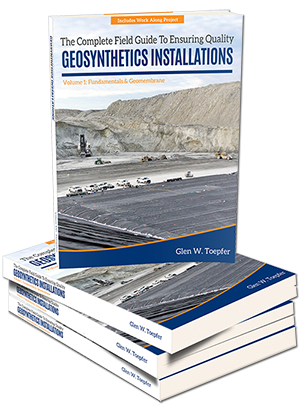ASTM D5641/D5641M – 16 has brought a little-known change to the industry standard on vacuum test requirements!
This new ASTM now states “For most cases, a minimum vacuum of 2 to 8 inches of mercury (1 to 4 psi) as registered on the vacuum gauge should be appropriate.” This is a substantial reduction from the “minimum vacuum of 28 to 55 kPa (4 to 8 psi)” required in ASTM D5641 – 94 (2011).
Nearly all of the project specifications our firm has dealt with this year (2017) have required a minimum vacuum test pressure of 5 psi and we have been strictly enforcing that pressure. Of countless installers we worked with, only one pointed out the change in the ASTM requirement, 2/3 of the way through the construction season.
The reduction in required pressure greatly changes the landscape of vacuum testing. Every installation crew we worked with this year did not have a vacuum box that could pull the required 5 psi when they arrived on site! Commonly, a Venturi system is required to meet the 5 psi requirement. In fact, most Shop-vac motors will only pull approximately 2.5 psi, even with a perfect seal.
Whether you are an owner, installer, certifying engineer, or technician in the field, it may be worth looking at what your project specifications say and getting an interpretation on the intent – at the pre-construction meeting or sooner!
I am curious to hear your thoughts on the change. Do you think the pressure is sufficient to adequately find leaks? Have you seen this change already or are people sticking with the age old standard of 5 psi?




We require 35 kPa as our standard VacBox suction requirement. Bad idea to reduce required pressure, as extrusion welds are the weakest link in the installed liner.
Fred, Thank you for your feedback. I have had several private e-mails/calls that echo your sentiments about the pressure being too low to be effective (and none thus far in support of the reduced pressure).
I also agree a lower pressure is not in the best interest of a leak free weld. The only part of a vacuum test spec I would like to see change would be the hold time. Ten to 15 seconds seems to be the standard. I would like to see it changed to 5 seconds. I have been installing for 28 yrs. After the initial 5 seconds Inspectors and technicians tend to look away, because very very seldom will a leak show after that period.
Thanks for sharing your thoughts Randy! I have mixed feelings on the dwell time being reduced. A lot of what is visible depends on the cleanliness of the seam being tested, as well as having a sound seal. I also agree that leaks showing up after 5 seconds are less frequent than in the first 5 seconds, but I also think you accurately use the word ‘seldom’ for those showing up after 5 seconds. The question for the industry then is do we accept ‘seldom’, and what is the risk versus reward for holding the vacuum another 5 seconds.
Many of the standards for the industry were simply put in place because something was needed as a guidance for installations – ie. the 500’ spacing of destructs is another example. Perhaps with roughly 30 years of installation experience, it is time to reevaluate some of these standards (as the GSI has done with recommendations on destructive test frequency). Does anyone have any data out there that would support reducing the vacuum test dwell time? How about data that supports reducing the vacuum test pressure? I would like to hear from any of you that have such data!
One in support of the reduced pressure…
I would be interested to know why the ASTM committee associated with this standard changed the vacuum required. I am thinking the vacuum requirement has been reduced because it was a crazy requirement in the first place. I have been installing membranes for 25 years and a vacuum of around 2-3 psi was always plenty. It would suck the membrane up into the chamber and easily show up any leakage through the seam or patch that was being examined. I don’t know where the 5psi requirement came from but I do know it was near impossible to achieve, of no additional use, and made “vac-boxing” extremely unwieldly; and may well have resulted in leaks that would have been detected using a lesser vacuum due to the cumbersome process of using compressors, venturis and associated paraphernalia, whilst the 3rd party CQA man/girl dutifully noted on his/her clip-board that the required 5psi vacuum had been achieved whilst the operator sighed with relief, wrestled the vacuum box off the membrane and went on to the next patch or tee.
The “old shop-vac motors” were adequate, still are and should remain; and Fred, you will be improving the lot and the goodwill of the conscientious installer if you go with the ASTM’s suggestion of a more sensible setting.